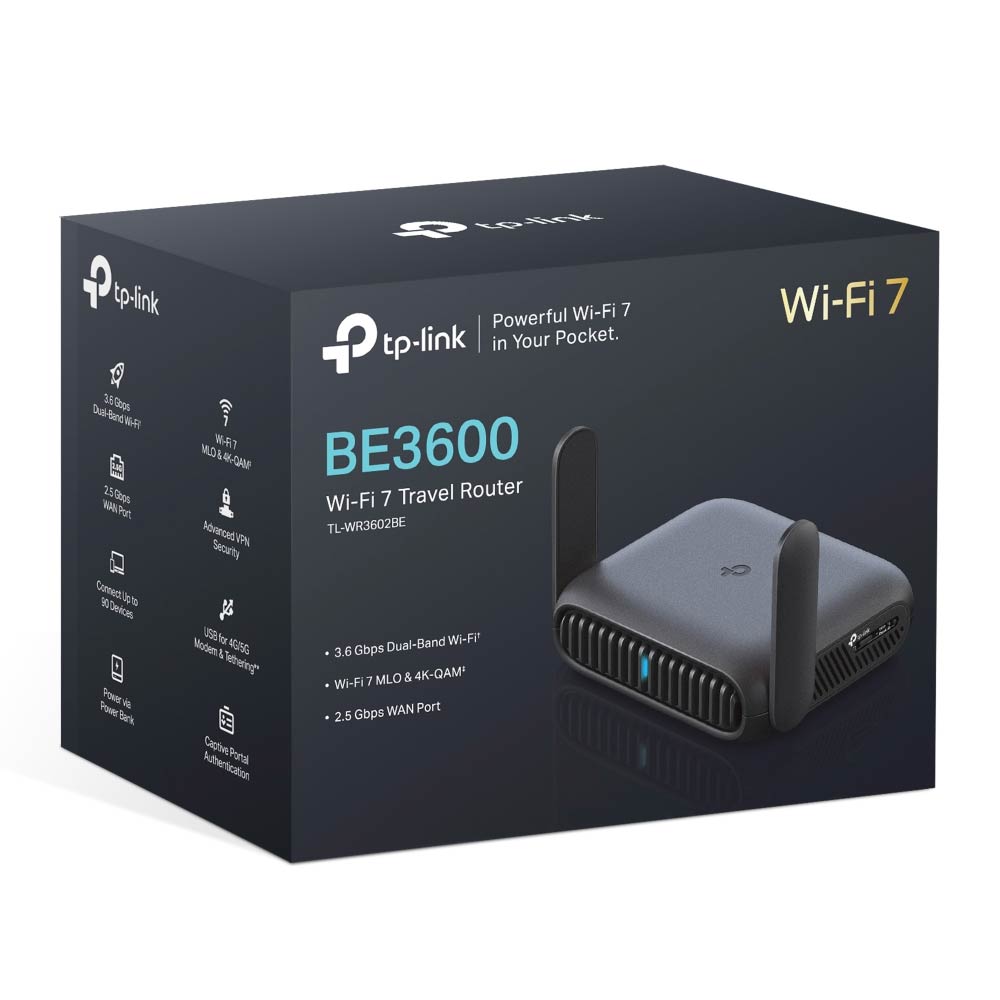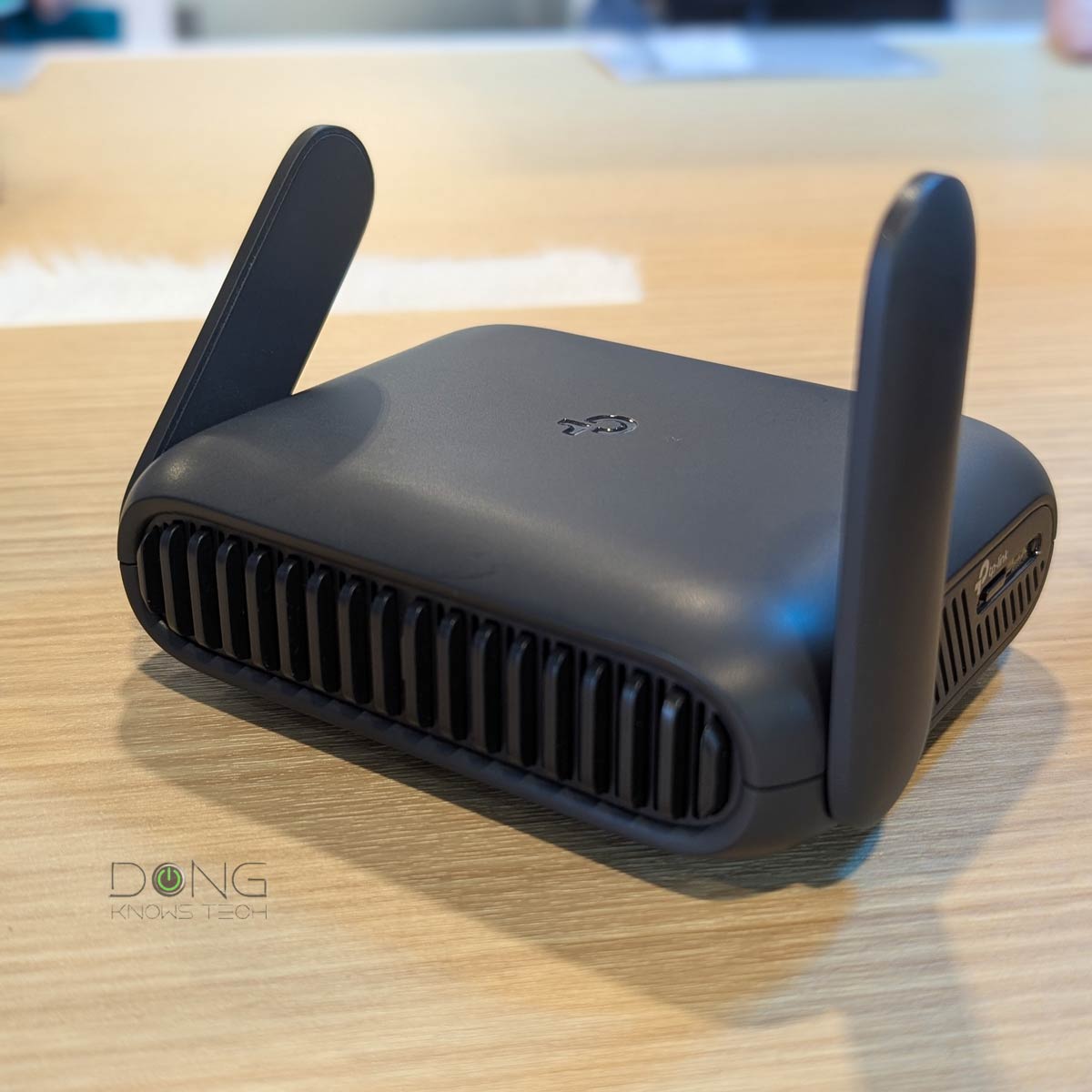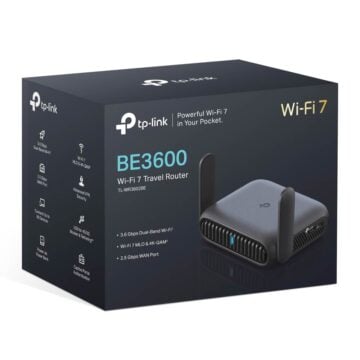TP-Link today announced the availability of the TL-WR3602BE travel router. First announced at the beginning of the year, this mobile router allows users Wi-Fi 7 connectivity while on the go, the first of its kind to do so for now, until others from competing vendors, such as the ASUS RT-BE58 Go, become available.
Other than that, it’s very similar to the TL-WR3002X Wi-Fi 6 couter part. So, the question is, is it worth the extra cost? Let’s find out more!

TP-Link TL-WR3602BE vs. TL-WR3002X: The same physical size now with external antennas and dual-band Wi-Fi 7
Physically, the TL-WR3602BE shares the same physical size as its older Wi-Fi 6 cousin, the TL-WR3002X, but now with two external antennas attached to its sides. That, plus the support for dual-band Wi-Fi 6, sets it apart.
It’s worth noting that the router’s support for Wi-Fi 7 is minimal, which is expected for a travel router. Specifically, the new router features BE3600, which is the same as the Archer BE230.
Other than that, the new router retains all the goodness of the TL-WR3002X, including a 2.5Gbps (WAN) port and a miniSD slot. The table below shows the hardware specs of the two.
TP-Link TL-WR3602BE vs. TL-WR3002X: Hardware specifications
 |  | |
|---|---|---|
| Full Name | TP-Link TL-WR3602BE BE3600 Wi-Fi 7 Travel Router | TP-Link TL-WR3002X AX3000 Wi-Fi 6 Travel Router |
| Model | TL-WR3602BE | TL-WR3002X |
| Dimensions (without antennas) | 4.09 × 3.54 × 1.10 in (104 × 90 × 28 mm) | |
| Weight | ≈ 6 oz (170 g) | 5.4 oz (153 g) |
| Wi-Fi Technology | Dual-band BE3600 | Dual-band AX3000 |
| 2.4GHz Band (channel width) | 2×2 BE: Up to 688 Mbps | 2×2 AX: Up to 578 Mbps |
| 5GHz Band(channel width) | 2×2 BE: Up to 2882 Mbps (20/40/80/160MHz) | 2×2 AX: Up to 2404 Mbps (20/40/80/160MHz) |
| Backward Compatibility | 802.11a/b/g/n/ac/AX | 802.11a/b/g/n/ac |
| Wireless Security | WPA, WPA2, WPA3 | |
| Built-in Cellular Modem | None | |
| Mobile App | TP-Link Tether | |
| Web User Interface | Yes | |
| Networking Features | VPN (Server and Client) Device-based QoS, Dynamic DNS | |
| VPN Server Support | OpenVPN WireGuard L2TP/IPSec PPTP | |
| Operating Roles | Router Mode USB Tethering Mode 3G/4G/5G USB Modem Mode Hotspot Mode (WISP Mode) Access Point Mode Range Extender Mode Client Mode | |
| Firmware Version (at review) | not yet reviewed | 1.0.3 Build 20250221 Rel. 47347(5553) |
| USB Port | 1x USB-C (power) 1x USB 3.0 (cellular tethering and storage) | |
| Card slot | 1x microSD | |
| Gigabit Port | 1x LAN | |
| Multi-Gig Port | 1x 2.5Gbps WAN | |
| Dual-WAN | Yes (broadband with cellular backup) | |
| Link Aggregation | No | |
| Power Intake | USB-PD via USB-C | |
| Power Consumption (per 24 hours) | TBD | ≈ 140 Wh |
| US Launch Price (Check street prices) | $139.99 | $99.99 |


Likely a familiar Archer router
As shown on the chart above, the support for Wi-Fi 7, which is a novelty, doesn’t make the TL-WR3602BE a massive leap over the TL-WR3002X: the two are just 600Mbps apart in terms of total theoretical bandwidth. In real-world usage, after the overhead, they might be identical in data rates, when used with Wi-Fi 7 clients—they always are when used with Wi-Fi 6 and older devices.
In terms of features and settings, the two are practically the same. Specifically, per TP-Link, you can use the TL-WR3602BE in the following ways:
- As a standard router: In this case, the router can host a standard internet connection via its 2.5Gbps WAN port, or a cellular modem/cellphone via the USB port. You can also use both at the same time, with the latter being the backup. It’s basically Dual-WAN with failover.
- As a hotspot: The router can connect to an existing Wi-Fi network and use it as the broadband source for its network. This mode is often known as the WISP mode, a.k.a. public Wi-Fi mode.
- As an access point, an extender (repeater), or a client (bridge).
Additionally, like the TL-WR3002X, the TL-WR3602BE can work as a flexible and advanced VPN solution as it features all popular VPN protocols, namely PPTP, L2TP, OpenVPN, and WireGuard, and supposedly can handle all of them simultaneously.
That said, other than the Wi-Fi 7 bragging rights, which can be significant, and the ostentatious antennas with their own allure, I’d say the TL-WR3602BE has little in real-world practical usage over the previous model. How much that extra translates into cash, as in the extra cost, is personal preference.
TP-Link TL-WR3602BE's PRELIMINARY Assessment

Pros
Compact design with 2.5Gbps WAN port and Wi-Fi 7 support
Useful features tailored to travelers, including multiple operation modes, built-in NAS capability, and advanced VPN support
Robust web user interface with a useful optional mobile app; standard USB-C charging
Cons
No built-in cellular modem
No battery option
Availability and pricing
The TP-Link TL-WR3602BE Dual-Band Wi-Fi 7 BE3600 Travel Router is available today with the suggested retail cost of $139.99. However, in the classic way of TP-Link’s hardware, you never have to pay the full price. The new router is now on Amazon with a $30 “launch” discount, making it just slightly more expensive than the previous model, which has other discounts of its own.
So, I’d say go for the Wi-Fi 7 bragging rights. Why not.



salutations dong ngo,
s’il vous plait, ici quel est la différence entre tl-wr3602be et
Archer be230 alias archer be3600,
est ce que archer be230 peut faire les mêmes fonctions que tl-wr3602be ?bien de choses à vous.
Here’s the review of the Archer BE230. Among other things, it’s not a travel router and does NOT have:
1. Cellular tethering.
2. WISP mode.
Hi Dong,
thanks for the review -. very helpful.
One Question: When using USB Tethering will the travel router power / charge the connected phone as well ? Or is it just data transmission ?
If not are you aware if I could connect a USB Splitter cable to the USB port of the phone. One goes to a charger for power supply of the phone, the other goes to the travel router to provide data connection via USB Tethering ?
thanks, Roland
I haven’t tested this one but I’m pretty sure it’s the same as the previous model on this front, meeaning, yes, it can charge the phone as well, albeit at no more than 15W output, likely lower.
Easy mesh?
Unlike those from Asus, which all support AiMesh, TP-Link’s travel rotuers generally don’t support EasyMesh, Greg.
no use without 4g/5G function.
You can tether a phone or a cellular modem. But you’re not wrong.
If you connect a router to a mobile phone hotspot, isn’t that like wearing a belt and suspenders?
That’s not tethering. You want to leave the phone in a non-hot-spot state and let the router do the job of Wi-Fi broadcasting. So, it’s more like having a roll cage instead of counting on a regular seatbelt to the extent the analogy applies.
Shouldn’t the WR3002X 5GHZ bandwidth in the chart read up to 2400 Mbps?
It should and has been fixed, Mark. The table merged incorrectly. Thanks.